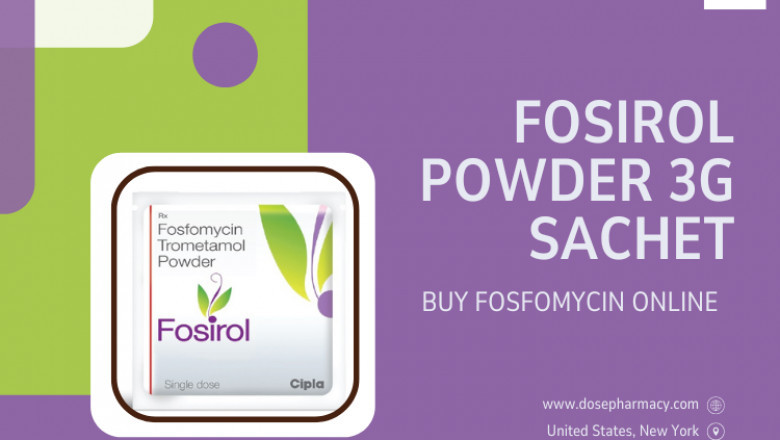views
Urinary tract infections (UTIs) are among the most common bacterial infections, particularly in women. They can cause significant discomfort and, if left untreated, may lead to more serious complications such as kidney infections. Among the various antibiotics used to treat UTIs, Fosfomycin 3gm Sachet has gained attention as a convenient and powerful treatment option. But how effective is fosfomycin for UTIs, and is it the right choice for you? This article explores the uses, effectiveness, and clinical insights surrounding fosfomycin for urinary tract infections.
What Is Fosfomycin?
Fosfomycin is a broad-spectrum antibiotic that works by inhibiting bacterial cell wall synthesis, ultimately killing the bacteria. It has been used for decades in Europe and other parts of the world and is approved by the U.S. FDA for the treatment of acute uncomplicated UTIs in women caused by Escherichia coli (E. coli) and Enterococcus faecalis.
Fosfomycin is most commonly prescribed in the form of a single-dose sachet (3 grams), which is dissolved in water and taken orally.
How Does Fosfomycin Work?
Fosfomycin targets an early step in bacterial cell wall synthesis, which makes it effective against a wide range of gram-negative and gram-positive bacteria. Its mechanism of action is unique, which also means cross-resistance with other antibiotic classes is rare.
This makes fosfomycin particularly useful for treating infections caused by multi-drug-resistant (MDR) bacteria, such as extended-spectrum beta-lactamase (ESBL)-producing E. coli.
How Effective Is Fosfomycin for UTIs?
✅ 1. High Cure Rates for Uncomplicated UTIs
Numerous studies have shown that fosfomycin is highly effective for acute uncomplicated UTIs, especially those caused by E. coli, which accounts for over 75% of community-acquired UTIs. You can also visit dosepharmacy to get more information about fosfomycin 3gm sachet.
Clinical trials report cure rates between 80–90% with a single 3-gram dose in women with uncomplicated cystitis. This makes it comparable to other first-line antibiotics like nitrofurantoin and trimethoprim-sulfamethoxazole.
✅ 2. Effective Against Resistant Strains
Fosfomycin is particularly valuable in treating UTIs caused by drug-resistant bacteria, such as:
-
ESBL-producing Enterobacteriaceae
-
Multidrug-resistant E. coli
-
Methicillin-resistant Staphylococcus aureus (MRSA) (in some contexts)
Because it works differently than most other antibiotics, bacteria that are resistant to penicillins, cephalosporins, or fluoroquinolones may still be sensitive to fosfomycin.
✅ 3. Long Half-Life Supports Single-Dose Use
Fosfomycin’s long urinary half-life allows it to remain active in the bladder for up to 48 hours, which helps kill bacteria and reduce the risk of recurrence. This pharmacokinetic profile is one of the main reasons why a single dose is often effective.
Advantages of Using Fosfomycin for UTIs
✅ 1. Single-Dose Convenience
Taking just one sachet makes it easy for patients to comply with treatment. Unlike many antibiotics that require 5–7 days of dosing, fosfomycin simplifies the process and improves adherence.
✅ 2. Low Risk of Resistance Development
Fosfomycin’s unique action and infrequent use reduce the risk of bacteria developing resistance to it, especially when compared to frequently prescribed antibiotics like ciprofloxacin.
✅ 3. Minimal Side Effects
Most people tolerate fosfomycin well. Common side effects are mild and may include:
-
Diarrhea
-
Headache
-
Nausea
-
Vaginal itching or discharge
Severe reactions are rare, and allergic responses are uncommon.
Limitations and Considerations
❌ 1. Not Suitable for Complicated UTIs
Fosfomycin is approved for acute uncomplicated UTIs in women. It may not be effective for:
-
Pyelonephritis (kidney infection)
-
UTIs in men
-
Catheter-associated UTIs
-
Recurrent or chronic UTIs (without additional doses)
❌ 2. Limited Data in Some Populations
While fosfomycin is widely used in adults, especially women, its safety and efficacy are not as well studied in:
-
Pregnant women
-
Children under 12
-
Elderly patients with multiple comorbidities
Physicians may still prescribe it off-label in some of these cases based on clinical judgment.
❌ 3. Geographic Resistance Variability
The effectiveness of fosfomycin may vary based on regional resistance patterns. Some areas are seeing increasing resistance rates, particularly in hospital-acquired infections. Therefore, culture and sensitivity testing may be recommended for recurrent or complex cases.
Comparing Fosfomycin with Other UTI Antibiotics
| Antibiotic | Duration | Resistance Risk | Effectiveness | Common Use |
|---|---|---|---|---|
| Fosfomycin | Single dose | Low | High for uncomplicated UTIs | First-line |
| Nitrofurantoin | 5–7 days | Low–Moderate | High | First-line |
| Trimethoprim-sulfamethoxazole | 3 days | Moderate–High | High (if susceptible) | First-line |
| Ciprofloxacin | 3–7 days | High | High | Reserved due to resistance |
| Amoxicillin-clavulanate | 5–7 days | Moderate | Variable | Second-line |
Fosfomycin is typically considered a first-line agent, especially when patient adherence or drug resistance is a concern.
When to Consider Fosfomycin
Your doctor may recommend fosfomycin if:
-
You have a simple bladder infection and prefer a one-time treatment.
-
You’re allergic or intolerant to other common antibiotics.
-
Your UTI is caused by drug-resistant bacteria, and cultures show sensitivity to fosfomycin.
-
You need a safe and easy treatment option for outpatient care.
How to Take Fosfomycin
-
Form: 3-gram sachet of granules
-
Administration: Mix with half a glass of water (do not use hot water) and drink on an empty stomach, ideally before bedtime.
-
Do not take with food, as this may reduce absorption.
Avoid taking other medications that affect kidney or bladder function around the time of taking fosfomycin unless instructed by your healthcare provider.
Yes, fosfomycin is a highly effective and convenient option for treating acute uncomplicated urinary tract infections in women. Its broad-spectrum activity, excellent safety profile, and single-dose administration make it a standout antibiotic, especially in an era of rising antibiotic resistance.
However, it is not suitable for every type of UTI, and healthcare providers should evaluate each case individually. Always consult your doctor to determine if fosfomycin is the right choice for your condition, especially if you have underlying health issues or recurrent infections.














Comments
0 comment